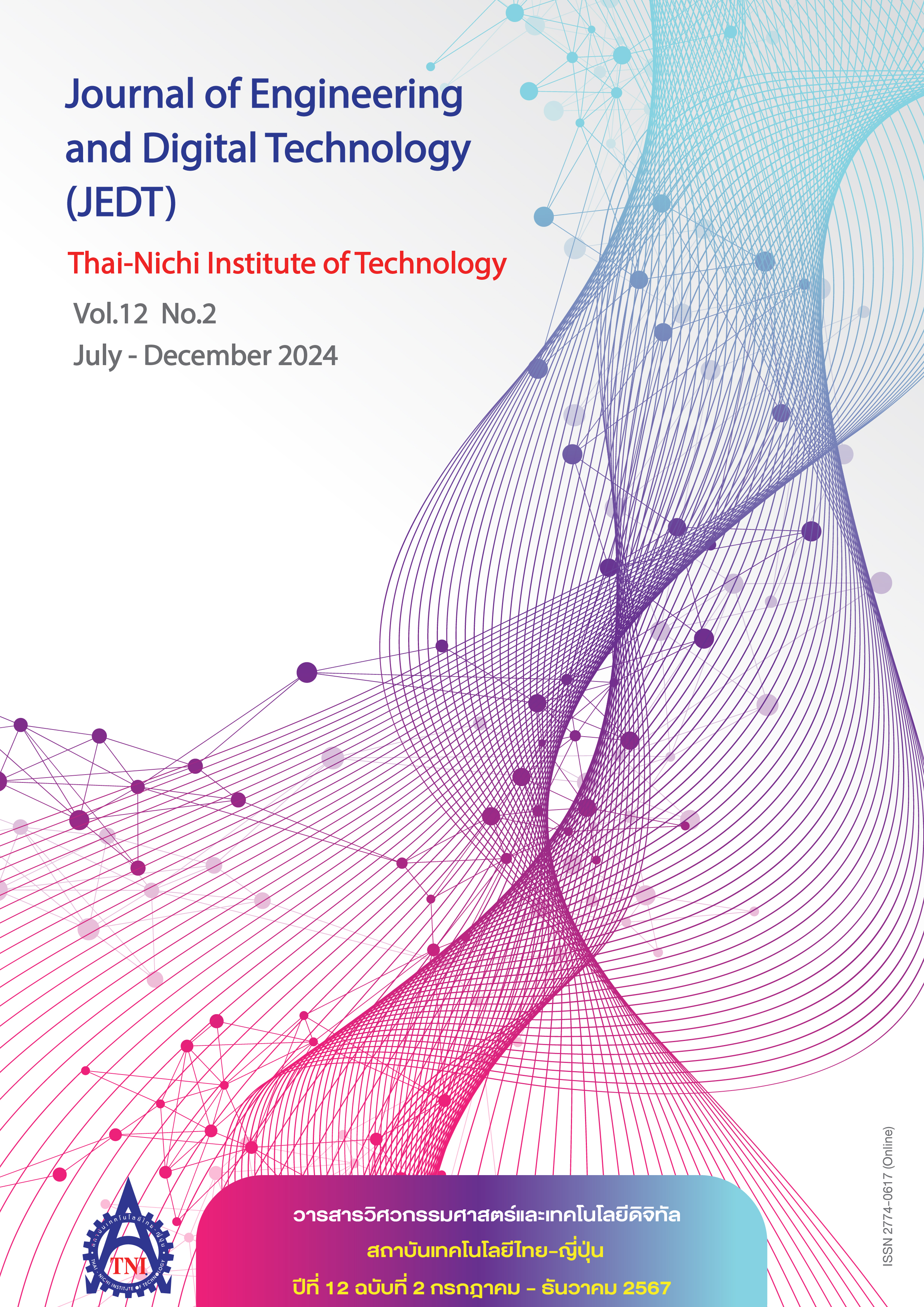ตัวแบบทำนายอาการเสียของเครื่องปรับอากาศชนิดรวมศูนย์แบบปรับน้ำยาแปรผันโดยใช้การเรียนรู้ของเครื่อง
Main Article Content
บทคัดย่อ
วัตถุประสงค์ในงานวิจัยนี้เพื่อพัฒนาตัวแบบทำนายอาการเสียของเครื่องปรับอากาศชนิดรวมศูนย์แบบระบบปรับน้ำยาแปรผัน โดยใช้การเรียนรู้ของเครื่อง ในส่วนเหตุการณ์การเสียของเครื่องปรับอากาศมาจากปริมาณสารทำความเย็น ผู้วิจัยได้ใช้ชุดโปรแกรม RapidMiner Studio ในการสร้างตัวแบบจากอัลกอริทึมทั้ง 4 ประเภท ได้แก่ Decision Tree, Naïve Bayes, Support Vector Machine และ Neural Networks ทั้งนี้ ได้ใช้ชุดข้อมูลเครื่องปรับอากาศชนิดรวมศูนย์แบบระบบปรับน้ำยาแปรผันมาจาก บริษัท เบตเตอร์ คูล จำกัด จำนวน 402 รายการ ซึ่งภายในชุดข้อมูลประกอบไปด้วย แรงดันสารทำความเย็น ค่าความเย็นยิ่ง (subcooled value) ค่าความร้อนยวดยิ่ง (superheated value) จำนวนเครื่องที่เปิด-ปิด และสถานะการทำงานเครื่องที่ทำงานปกติและผิดปกติ เพื่อใช้ในการประเมินประสิทธิภาพค่าความแม่น (accuracy) ค่าความเที่ยง (precision) ค่าความระลึก (recall) และค่าความถ่วงดุล (F-Measure) แล้วนำมาเปรียบเทียบค่าประสิทธิภาพกับอัลกอริทึมต่าง ๆ ซึ่งอัลกอริทึมที่มีประสิทธิภาพสูงสุดได้แก่ Neural Networks โดยมีค่าความแม่นร้อยละ 95.04 ค่าความเที่ยงร้อยละ 94.17 ค่าความระลึกร้อยละ 100 และค่าความถ่วงดุลร้อยละ 97.00 ทำให้ได้ผลของการทำนาย สถานะทำงานปกติหรือผิดปกติ
อย่างไรก็ดี ผู้วิจัยได้พัฒนาขยายผลตัวแบบโดยใช้เทคนิค Hybrid Ensemble Method แบบ Stacking มีการใช้อัลกอริทึมที่มีค่าประสิทธิภาพสูงสุดและรองลงมาสองอันดับ ได้แก่ Neural Networks, Decision Tree และ Naïve Bayes ในการจำแนก ทำให้ได้ค่าประสิทธิภาพที่สูงขึ้นจากเดิมด้วยค่าความแม่นมากถึงร้อยละ 95.52 ค่าความเที่ยงร้อยละ 97.21 ค่าความระลึกร้อยละ 97.21 และค่าความถ่วงดุลร้อยละ 97.21
Article Details

This work is licensed under a Creative Commons Attribution-NonCommercial-NoDerivatives 4.0 International License.
นโยบายการรับบทความ
กองบรรณาธิการวารสารสถาบันเทคโนโลยีไทย-ญี่ปุ่น มีความยินดีรับบทความจากอาจารย์ประจำ และผู้ทรงคุณวุฒิในสาขาวิศวกรรมศาสตร์และเทคโนโลยี ที่เขียนเป็นภาษาไทยหรือภาษาอังกฤษ ซึ่งผลงานวิชาการที่ส่งมาขอตีพิมพ์ต้องไม่เคยเผยแพร่ในสิ่งพิมพ์อื่นใดมาก่อน และต้องไม่อยู่ในระหว่างการพิจารณาของวารสารอื่นที่นำส่ง ดังนั้นผู้สนใจที่จะร่วมเผยแพร่ผลงานและความรู้ที่ศึกษามาสามารถนำส่งบทความได้ที่กองบรรณาธิการเพื่อเสนอต่อคณะกรรมการกลั่นกรองบทความพิจารณาจัดพิมพ์ในวารสารต่อไป ทั้งนี้บทความที่สามารถเผยแพร่ได้ประกอบด้วยบทความวิจัย ผู้สนใจสามารถศึกษาและจัดเตรียมบทความจากคำแนะนำสำหรับผู้เขียนบทความ
การละเมิดลิขสิทธิ์ถือเป็นความรับผิดชอบของผู้ส่งบทความโดยตรง บทความที่ได้รับการตีพิมพ์ต้องผ่านการพิจารณากลั่นกรองคุณภาพจากผู้ทรงคุณวุฒิและได้รับความเห็นชอบจากกองบรรณาธิการ
ข้อความที่ปรากฏภายในบทความของแต่ละบทความที่ตีพิมพ์ในวารสารวิชาการเล่มนี้ เป็น ความคิดเห็นส่วนตัวของผู้เขียนแต่ละท่าน ไม่เกี่ยวข้องกับสถาบันเทคโนโลยีไทย-ญี่ปุ่น และคณาจารย์ท่านอื่น ๆ ในสถาบัน แต่อย่างใด ความรับผิดชอบด้านเนื้อหาและการตรวจร่างบทความแต่ละบทความเป็นของผู้เขียนแต่ละท่าน หากมีความผิดพลาดใด ๆ ผู้เขียนแต่ละท่านจะต้องรับผิดชอบบทความของตนเองแต่ผู้เดียว
กองบรรณาธิการขอสงวนสิทธิ์มิให้นำเนื้อหา ทัศนะ หรือข้อคิดเห็นใด ๆ ของบทความในวารสารสถาบันเทคโนโลยีไทย-ญี่ปุ่น ไปเผยแพร่ก่อนได้รับอนุญาตจากผู้นิพนธ์ อย่างเป็นลายลักษณ์อักษร ผลงานที่ได้รับการตีพิมพ์ถือเป็นลิขสิทธิ์ของวารสารสถาบันเทคโนโลยีไทย-ญี่ปุ่น
ผู้ประสงค์จะส่งบทความเพื่อตีพิมพ์ในวารสารวิชาการ สถาบันเทคโนโลยีไทย-ญี่ปุ่น สามารถส่ง Online ที่ https://www.tci-thaijo.org/index.php/TNIJournal/ โปรดสมัครสมาชิก (Register) โดยกรอกรายละเอียดให้ครบถ้วนหากต้องการสอบถามข้อมูลเพิ่มเติมที่
- กองบรรณาธิการ วารสารสถาบันเทคโนโลยีไทย-ญี่ปุ่น
- ฝ่ายวิจัยและนวัตกรรม สถาบันเทคโนโลยีไทย-ญี่ปุ่น
เลขที่ 1771/1 สถาบันเทคโนโลยีไทย-ญี่ปุ่น ซอยพัฒนาการ 37-39 ถนนพัฒนาการ แขวงสวนหลวง เขตสวนหลวง กรุงเทพมหานคร 10250 ติดต่อกับคุณพิมพ์รต พิพัฒนกุล (02) 763-2752 , คุณจุฑามาศ ประสพสันติ์ (02) 763-2600 Ext. 2402 Fax. (02) 763-2754 หรือ E-mail: JEDT@tni.ac.th
References
Department of Public Works and Town & Country Planning. “Roles and Responsibilities.” DPT.go.th. https://www.dpt.go.th/th/powers-and-duties-of-departments-and-government-agencies (accessed Oct. 19, 2023).
Green Government Office Design Guidelines for New Construction. G-Goods : NC Version 1.0 (in Thai), Department of Public Works and Town & Country Planning, Dec. 2022. [Online]. Available: https://www.dpt.go.th/th /documents-dpt/961
R. E. Neapolitan and X. Jiang, Artificial Intelligence: With an Introduction to Machine Learning, 2nd ed. New York, NY, USA: Chapman and Hall/CRC Press, 2018.
T. Jo, “Introduction,” in Machine Learning Foundations: Supervised, Unsupervised, and Advanced Learning. Cham, Switzerland: Springer International Publishing, 2021, ch. 1, pp. 1–15.
B. Charbuty and A. M. Abdulazeez, “Classification based on decision tree algorithm for machine learning,” J. Appl. Sci. Technol. Trends, vol. 2, no. 1, pp. 20–28, Jan. 2021.
N. S. Chauhan. “Decision Tree Algorithm, Explained.” KDNUGGETS.com. https://www.kdnuggets.com/2020/01/decision-tree-algorithm-explained.html (accessed Feb. 19, 2024).
T. N. Viet, H. L. Minh, L. C. Hieu, and T. H. Anh, “The Naïve Bayes algorithm for learning data analytics,” Indian J. Comput. Sci. Eng., vol. 12, no. 4, pp. 1038–1043, 2021.
R. Akbani, S. Kwek, and N. Japkowicz, “Applying support vector machines to imbalanced datasets,” in Proc. 15th Eur. Conf. Mach. Learn., Pisa, Italy, Sep. 2004, pp. 39–50.
A. C. Müller and S. Guido, “Supervised Learning,” in Introduction to Machine Learning with Python: A Guide for Data Scientists. Sebastopol, CA, USA: O'Reilly Media, 2016, ch. 2, pp. 106–120.
S. Bandgar. “Support Vector Machine.” MEDIUM.com. https://medium.com/nerd-for-tech/support-vector-machine92fa3c57d33b (accessed Feb. 19, 2024).
S. Krishna. “Building an Artificial Neural Network(ANN).” MEDIUM.com. https://medium.com/@saikrishna3599/building-an-artificial-neural-network-ann-502a63d76fb3 (accessed Jun. 30, 2020).
S. Pal and S. Paul, “Linking hydrological security and landscape insecurity in the moribund deltaic wetland of India using tree-based hybrid ensemble method in python,” Ecological Inform., vol. 65, Sep. 2021, Art. no. 101422.
J. Zhao, J. Jin, S. Chen, R. Zhang, B. Yu, and Q. Liu, “A weighted hybrid ensemble method for classifying imbalanced data,” Knowl.-Based Syst., vol. 203, Jun. 2020, Art. no. 106087.
T. Srivastava. “12 Important Model Evaluation Metrics for Machine Learning Everyone Should Know (Updated 2023).” ANALYTICSVIDHYA.com. https://www.analyticsvidhya.com/blog/2019/08/11-important-model-evaluation-error-metrics/ (accessed Jan. 8, 2024).
A. Elmouatamid, B. Fricke, J. Sun, and P. W. T. Pong, “Air conditioning systems fault detection and diagnosis-based sensing and data-driven approaches,” Energies, vol. 16, no. 12, Jun. 2023, Art. no. 4721.
M. Yang, L. Cheng, M. Cao, and X. Yan, “A stacking ensemble learning method to classify the patterns of complex road junctions,” ISPRS Int. J. Geo-Inf., vol. 11, no. 10, Oct. 2022, Art. no. 523, doi: 10.3390/ijgi11100523.

